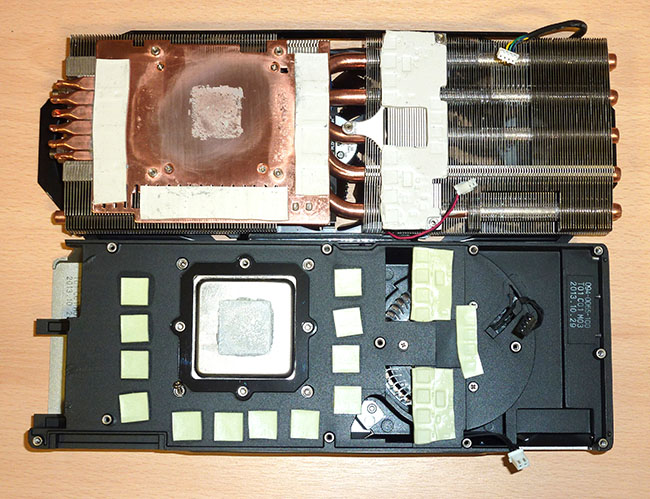Bundled in with WindForce OC
While AMD has made much noise and fanfare for its dual-GPU Radeon R9 295X2 beastie launched last month, Nvidia's been curiously quiet on Titan Z. If reports are to be believed, this £2,200 card is delayed, leaving the ultra-high-end to AMD for the time being.
But there remain readers unconvinced that dual GPUs are the way forward, irrespective of the frame-pacing progress claims made by both companies, and would rather sacrifice performance for smoother gameplay. Here, Nvidia has the upper hand, with GeForce GTX 780 Ti arguably better than the Radeon R9 290X.
The £500 GTX 780 Ti is our choice of high-end card but it isn't the fastest in Nvidia's arsenal - that honour goes to GTX Titan Black, announced in February this year and retailing from £750. The extra 50 per cent cash buys you twice the framebuffer - 6GB vs. 3GB - faster double-precision support and marginally higher frequencies.
Nvidia is seeding select partners with GTX Titan Black cards, complete with the high-quality reference cooler we've come to admire. Partners are not allowed to retail cards with their own cooling, in stark contrast to GTX 780 Ti, so it would seem the only possible differentiation rests with qualifying higher speeds and charging a premium for doing so.
Gigabyte sells two GTX Titan Black cards. The first chimes in at standard speeds of 889MHz core (980MHz Boost) and 7,000MHz memory. The second, known as GV-NTITANBLKGHZ-6GD-B, is more interesting insofar as it's overclocked to 1,006MHz core (1,111MHz Boost) though memory, supplied by Hynix, remains at the same speed.
However, as a further nod towards the enthusiast nature of the card Gigabyte also bundles in its WindForce 3X 600W cooling system in the same box. The premise here is that, adhering to Nvidia's strictures, the end user removes the reference cooler and straps on the WindForce instead.
The regular Titan Black in usual Nvidia livery. The only concession to this being a partner card is the Gigabyte sticker on the PCB section near the slot and, on the far side, a company-branded sticker that feels like an afterthought. Gigabyte, let's remember, has no choice in how the reference card is presented and shipped out to the customer.
The bundled WindForce 3X 600W cooler is new to Gigabyte's arsenal, supplanting the 450W model present on most of its high-end cards. Bigger is better with regards to heat dissipation, of course, and Gigabyte upgrades the triple-fan cooler by using six heatpipes - four fat and two thin - across the two-part heatsink, as shown below.
The Gigabyte WindForce 3X 600W on the top and the removed reference Titan Black cooler on the bottom. The WindForce cooler has the same thermal-tape locations and heatsink cutout (for the 8+6-pin power delivery) as the reference card.
Gigabyte includes a T6H Torx wrench needed to remove 16 screws from the reference card. Four central screws and two bracketed screws come away by using a regular Philips-head 'driver. WindForce 3X 600W is the same width as the reference model but, given the way it mounts, overhangs the right-hand side by an inch or so.
The entire cooler-swapping procedure takes less than 10 minutes, and Gigabyte also includes a two-pin connector that powers the cool blue logo on the far side. Separate screws, bundled, are used to mount the WindForce cooler onto the PCB - the reference card's don't fasten correctly. Really, it's a shame that Gigabyte has to go through the expense of bundling in the cooler as well as the reference heatsink.
It's only the cooler that's different from reference, thus the rear outputs of twin dual-link DVI, HDMI and DisplayPort remain intact, all of which can be used concurrently.
There's good reason to use better-than-reference cooling on a Titan Black, mind you, as the in-game frequency is dictated in large part by the temperature. Cooler cores clock higher under Nvidia's GPU Boost, meaning that the very same card can run faster if equipped with better cooling.
Here's the hard part to swallow. This WindForce-equipped card is likely to ship for around £840. With that bitter pill out of the way, let's get on to some 4K benchmarks.













